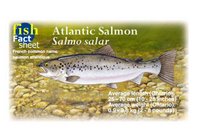
- * The Kensington Hatchery on Old Hatchery Road is one of three sites in the state involved in the Atlantic Salmon restoration project designed to bring the prized fish back to Connecticut streams. Since the early 1980s, the 46- acre Berlin facility has been devoted to hatching Atlantic salmon. As Albin J. Sonski, hatchery manager, puts it, “My job is to make fish.”
- * The facility is under the state’s Department of Environmental Protection, Fisheries Division, Bureau of Natural Resources. The four-man operation, the smallest in the state, requires the maintenance of 75 pond units. It is not open to the public.
- * Restoring Atlantic salmon in the Connecticut River basin is a joint undertaking by the states of Vermont, New Hampshire, Massachusetts and Connecticut along with the U.S. Fish and Wildlife Service of the National Marine Fisheries Service. The project began with an act of Congress in 1983. The Atlantic salmon was native to Connecticut before the dams built for industrial purposes in the 1800s drove it to extinction in this region.
- * “Atlantic salmon is very difficult to raise,” Sonski said. The fish spawn in October and produce about 3 million eggs at the Kensington hatchery. The hatchery’s bio-technology methods produce about a million “eyed-eggs’ a year, about 850,000 of which survive to become fry, one-inch baby fish.
- * The federally operated hatchery in Mass. allocates 20,000 eggs to the Kensington facility. These eggs come from adults returning to the ocean. Of those about 1,000 will eventually become 4-year-old brood fish at the Kensington facility and the remainder will be stocked as fry. The brood fish are used only once by the hatchery and then released into streams. It sounds like a lot of fish, but the final outcome of the careful spawning, raising and stocking of Atlantic salmon shows a dramatic mortality rate. An anadromous fish, salmon are born in fresh water, later migrate to ocean salt water and then seek to return to the rivers for spawning. “They want to go into the rivers and they can’t. There are dams all over,” Sonski said.
- * Released adult fish are often killed by predators, including fishermen, and may die from any number of other causes, before they have a chance to return home to fresh water to spawn a new generation, Sonski said. “We do have returning salmon to the Salmon River and the Farmington River,” Sonski said.
- * However, Sonski said the status of the project is “scary.” There are just 150 to 300 adult fish that return to the rivers. “It’s been like that for several years,” he said. The best year was back in the late 1980s when one year over 580 fish returned. The fish are hand counted at fish traps located at fish ways at dams.
- * With the time invested — more than two decades — and the money, there is a lot of discussion and, of course, some controversy attached to the project, Sonski said. He compared the difficulties in raising Atlantic salmon to that of raising brown trout like the difference between “weeds and roses.” The hatchery also raises trout and stocked Connecticut rivers with about 150,000 fry this spring.
- * It’s going to take more time and more effort Sonski said of the Atlantic salmon project. Part of that effort is getting dam owners to work with the restoration project. There needs to be more accommodation to help the fish by-pass the risky plunge over the dam or the route through the dam turbines that surely will kill them. In 2002, legislation that included the Connecticut River Compact (and the Atlantic salmon project) was reauthorized for an additional 20 years. However, essential funding for the program was not fully addressed, according to information from the Connecticut River Salmon Association.
- * Sonski explained why he thinks the Atlantic salmon project is a valuable conservation effort. “It’s like asking why is it important to keep the American bald eagle from going extinct,” he said. [Kensington Hatchery involved in restoration project By Olivia L. Lawrence, The Berlin Citizen 4/20/06]
No comments:
Post a Comment